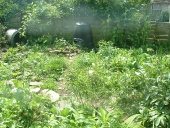
 29
29




 25
25




 14
14




The best gardening course: https://gardenmastercourse.com
Permies.com FAQ
 5
5




Forever creating a permaculture paradise!
 12
12




 5
5




Forever creating a permaculture paradise!
 15
15




Visit Redhawk's soil series: https://permies.com/wiki/redhawk-soil
How permies.com works: https://permies.com/wiki/34193/permies-works-links-threads
 11
11





 10
10




How Permies works: https://permies.com/wiki/34193/permies-works-links-threads
My projects on Skye: The tree field, Growing and landracing, perennial polycultures, "Don't dream it - be it! "
 5
5




 6
6




 8
8




Interesting info you found. Did you know that Hummingbirds do that too? We don't tend to think of hummingbirds as insectivores, but particularly if they're feeding young, having insects around to add that protein is very important. More reasons for letting Mother Nature balance the scales and humans just planting lots of diversity!Nancy Reading wrote: They feed these protein rich foods to their larvae, the adults having more of a taste for sweeter foods like nectar and fruit.
Visit Redhawk's soil series: https://permies.com/wiki/redhawk-soil
How permies.com works: https://permies.com/wiki/34193/permies-works-links-threads
 7
7




Jen Swanson wrote:Thanks for sharing the great pics! I love to see beneficial insects in my garden and encourage them by planting lots of flowers that they are attracted to around my vegetable beds. I rarely use even organic pesticides, but I do sometimes use Bt on cabbage worms when the infestations become intolerable. One treatment usually does the trick. Bt is allowed in organic farming as a insecticide because it is a natural, non-pathogenic bacterium that is found naturally in the soil. It targets only the larvae of butterflies and moths, and is not toxic to anything else, including beneficial insects. I've too have tried chasing down the cabbage whites. They are really hard to catch! The Bt works much better :)
 5
5




Deb Skye wrote:Thanks for the nice photos, Jeff. I'm with you, this is a big year for the cabbage moth caterpillars, esp. on the kale. My tactic has been to check daily and fling them as far as I can. Hopefully they're too far to find their way back.
I also tolerate whatever comes into the yard. It all works together. Except squirrels, no squirrels, lol!
 6
6




Nancy Reading wrote:I try and tolerate wasps as much as I can. My husband gets very nervous about them, as do I. I suspect that is an ingrained reaction to buzzy things and the black and yellow colouring. Apparently they eat many other pests and a few friends: spiders, caterpillars, ants, bees, flies, beetles, crickets, aphids, grasshoppers, cicadas, whiteflies, and sugar cane borers (source). They feed these protein rich foods to their larvae, the adults having more of a taste for sweeter foods like nectar and fruit.
 6
6





 5
5




 4
4




 10
10




 6
6




 4
4




“Action on behalf of life transforms. Because the relationship between self and the world is reciprocal, it is not a question of first getting enlightened or saved and then acting. As we work to heal the earth, the earth heals us.” ~ Robin Wall Kimmerer
 8
8




 6
6




Heather Sharpe wrote:I've been noticing an abundance of wasp and hornet type beings in my garden this year. As well as a virtual absence of cabbage white caterpillars and fewer aphids, which those creatures also eat. I haven't had any issues so far coexisting peacefully with them. I just discovered a sizeable bald faced hornet nest only a foot or two above the path I walk every morning. It was hidden in yew foliage. The fact it's been there this long and I didn't know says to me they aren't very aggressive. Now I go talk to them in a calm voice to let them know I mean them no harm in walking past. Apparently, in addition to eating the caterpillars and aphids, they can eat so many of the more aggressive yellow jackets that some of their nests are yellow on the inside! Yellow jackets are the only ones who've ever been aggressive towards me, so I'm fine with the bald faced hornets.
I think when possible, working with and around these beings is worth it. Especially since it seems that most of them only use their nests until the first frost, when all but the queen perish. Then she rebuilds in a new location in the spring.
 6
6




 4
4




 3
3




Steve Mendez wrote:
The wasps that fly around with their legs dangling down are usually less aggressive than the wasps that fly with their legs tucked up against their body.
I have noticed that the wasps that patrol our cabbage, kale, broccoli, and kohlrabi have dangling legs and are taking the small green caterpillars that they capture to their umbrella shaped paper nests under the eaves of the shed.
 6
6




John Duffy wrote:
just tell hubby it's a new protein supplement...Worms are tasty!...ask any fish; ( a little garlic butter helps)
Forever creating a permaculture paradise!
 3
3




"The world is changed by your example, not your opinion." ~ Paulo Coelho
 2
2




Welcome to the serfdom.




 1
1








"Never be within doors when you can rightly be without." ~ Charlotte Mason

 1
1





|
ice is for people that are not already cool. Chill with this tiny ad:
Rocket Mass Heater Resources Wiki
https://permies.com/w/rmh-resources
|







